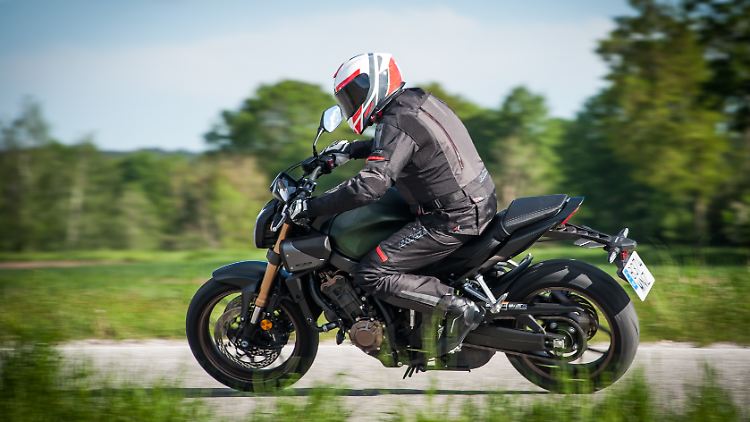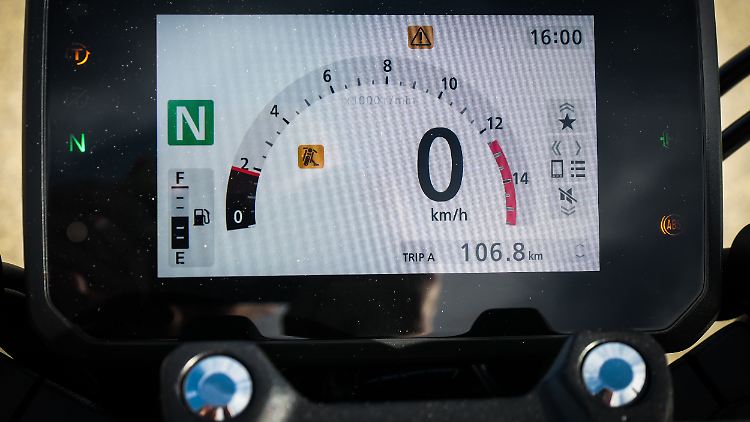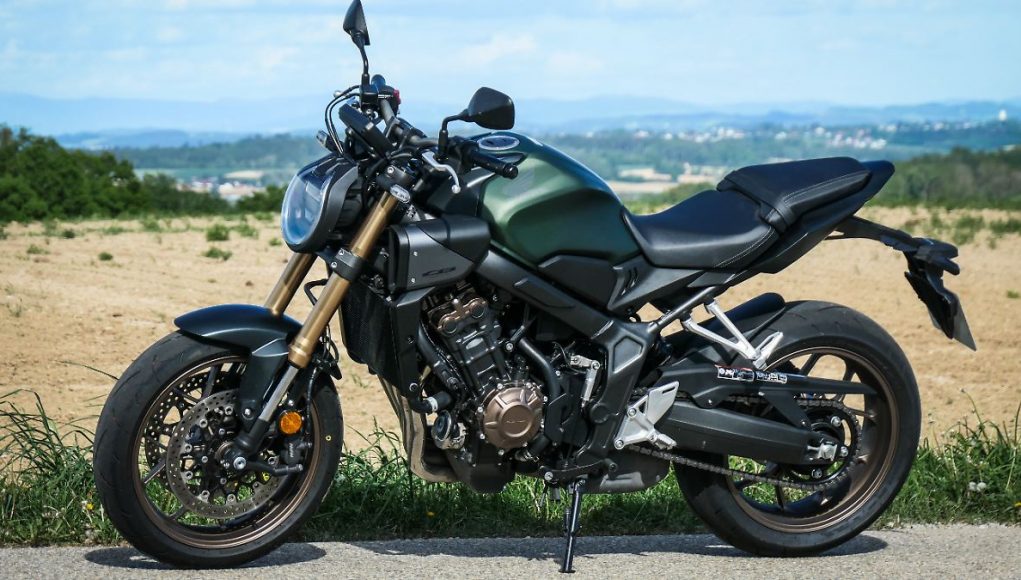Renewed naked bike in test
Honda CB650R with E-Clutch – why not?
This audio version was artificially generated. More info | Send feedback
The revised Honda CB650R shows why a four-cylinder in-line engine is a highly attractive motorcycle engine even in the age of two-cylinder engines. Especially when it is combined with an automatic clutch.
It has been five years since Honda expanded its small CB series with a 650cc model; previously it had only consisted of the CB1000R and the CB125R. The mid-range machine, equipped with a liquid-cooled four-cylinder in-line engine, immediately became one of Honda's most important models: over 41,000 units found their way onto Europe's streets. In order to stabilize its success, the Japanese manufacturer has now moderately revised the very powerful naked bike with 70 kW/95 hp and kept the price just under four figures at 9800 euros.


The price of the Honda CB650R remains under 10,000 euros – just about.
(Photo: Honda/Rita Niehues/sp-x)
Changes can be found not only in the styling, but also in the technology: Both the engine and the chassis as well as the electronics and lighting have been modified; in addition, the 2024 CB650R, together with its super-sporty sister model CBR650R, is the first Honda with the new E-Clutch, i.e. an automatic clutch.
Changes small but noticeable
The engine data suggests that nothing has happened to the engine, because it is unchanged. The changes are small but noticeable. New timing of the intake valves means that the 650 feels more powerful at low revs, thus concealing the fundamental shortcoming of the inline four. The refined ram air system also helps with this.


The 650 feels more powerful at low revs thanks to new intake valve timing.
(Photo: Honda/Rita Niehues/sp-x)
At the top end, i.e. beyond 9500 rpm, the Honda continues to set off fireworks to the delight of speed fans. It still adds a lot of power and speed when two-cylinder engines have long since lost their enthusiasm. Nevertheless, its fuel consumption is up to date; in mixed traffic, the test bike, which is homologated according to the latest Euro 5+ standard, was satisfied with 5.1 liters per 100 kilometers, which was only slightly above the standard consumption of 4.9 l/100 km. The 15.4-liter tank therefore allows 300 kilometers without refueling, albeit only just.
The dimensions and measurements of the chassis are unchanged from the previous model, but the rear frame has been slimmed down and is now almost 500 grams lighter; the shape is now sleeker, but there is no loss of practicality. There is plenty of space, and the ergonomics are good for people between 1.70 and 1.90 meters tall. You sit upright, but slightly oriented towards the front wheel.


The display of the Honda CB650R is clearly designed.
(Photo: Honda/Rita Niehues/sp-x)
The new five-inch TFT display is perfectly in view; it is clearly designed, offers three layouts to choose from and also allows a white or black background. If the Honda RoadSync app is installed on the smartphone, full connectivity (music, phone, messages) is available; the route information is provided as arrow navigation. The on-board computer is easy to operate using the new, backlit 4-way switch on the left handlebar unit.
Be careful when stopping


A liquid-cooled four-cylinder in-line engine drives the Honda CB650R with E-Clutch.
(Photo: Honda/Rita Niehues/sp-x)
The on-board computer is also necessary to activate or deactivate the automatic clutch. If you want, you can forget about the clutch lever completely, even when engaging first gear and when starting and stopping. Gear changes are generally made using the foot shift lever, but you can also engage the clutch yourself in automatic mode.
You only need to be careful when stopping: the driver himself must – if he is still in third gear, for example – engage first gear when stationary in order to be able to drive off again. Without the clutch, of course. In practice, the automatic clutch is clearly superior to the quickshifter; the gear changes are cleaner and a little faster.
And the two kilograms extra weight compared to the standard model is irrelevant; the surcharge of 400 euros for the E-Clutch seems reasonable, because a quickshifter already costs 260 euros.
All in all, the 2024 version of the Honda CB650R makes an excellent impression: Its appearance is fresh and attractive and its technology is state-of-the-art. It is very easy to operate and the handling characteristics are impeccable up to the top speed of around 200 km/h. Thanks to the smooth running of the engine, it is possible to roll through towns at 2000 rpm or to downshift again at 10,000 rpm and let the machine really rejoice.


Attractive appearance, state-of-the-art technology, well-made – the conclusion about the Honda CB650R with e-Clutch is positive.
(Photo: Honda/Rita Niehues/sp-x)
The workmanship appears to be of the usual high quality. What makes the CB650R attractive is that it is also available as an A2 version with 35 kW/48 hp – in this class it stands alone with its inline four-cylinder engine. Fans of this engine concept have every reason to be happy about the Honda update.
Technical data Honda CB650R (with e-Clutch)
- engine: Liquid-cooled four-cylinder in-line engine, 16 valves, DOHC, 649 cc displacement, 70 kW/95 hp at 12,000 rpm, 63 Nm at 9,500 rpm; injection, 6 gears, automatic clutch E-Clutch, chain drive
- landing gear: Steel bridge frame; front USD telescopic fork ø 41 mm, 10.8 cm travel; rear light alloy cast double-sided swing arm, central spring strut, adjustable preload, 12.8 cm travel; light alloy cast wheels; tubeless tires 120/70 ZR 17 (front) and 180/55 ZR 17 (rear). 31 cm double disc brake at the front, 24 cm single disc brake at the rear
- Assistance systems: Dual-circuit ABS, switchable traction control, antihopping clutch, TFT display with connectivity via smartphone
- mass and weight: Wheelbase 1.45 m, seat height 81 cm, weight ready to drive 207 kg, payload 165 kg; tank capacity 15.4 litres
- Driving performance: Top speed 197 km/h, 0-100 km/h approx. 3.8 sec. Standard consumption according to EU5+ 4.9 l/100 km
- Colors: Grey, Green, Red, Black
- Availability: from now on
- Price: from 9790 Euro including additional costs (incl. e-Clutch)































